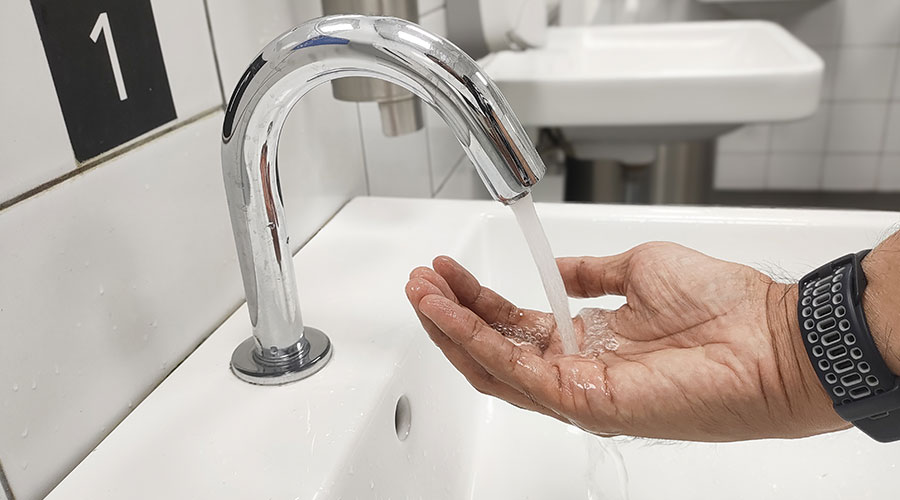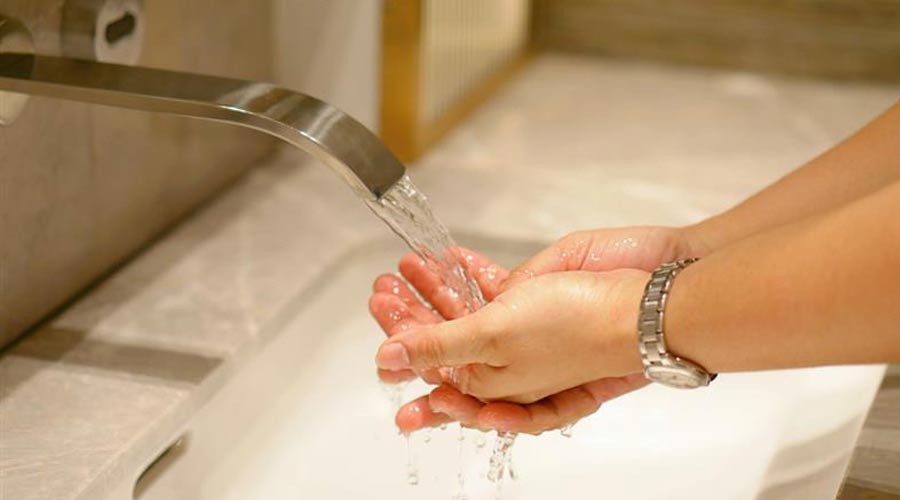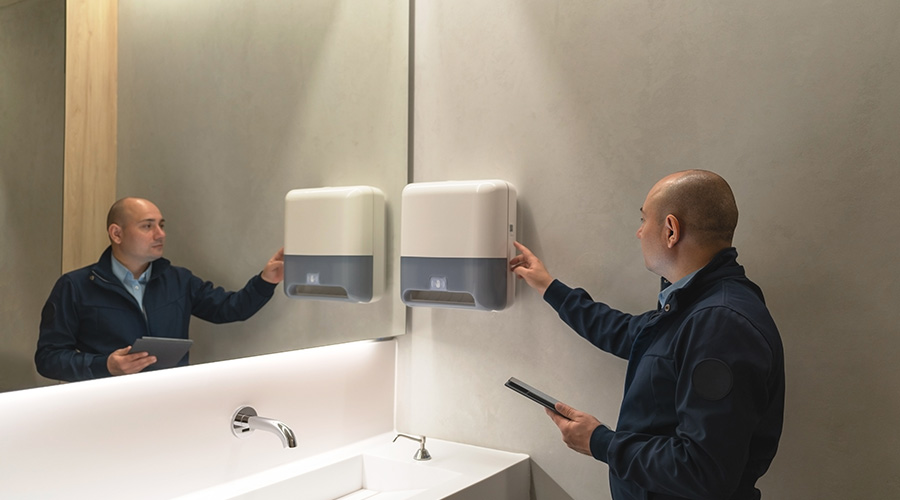Restrooms
Function and Image: 6 Steps to Cost-Effective Design
The privy, the john, the lav — restrooms go by many names, and their designs can vary widely. However, all have one trait in common: some thought and planning can help ensure that they’re built and operated as cost-effectively as possible, for as long as possible.
When looking at a restroom design or renovation, it’s easy to focus on the up-front costs. However, those aren’t the only costs to consider. “You want to control the cost of the product itself, and look at products that reduce maintenance time, as well as wasted tissue, soap or water,” says John Drengler, senior segment manager with SCA Tissue North America, Neenah, Wis. It often is less expensive in the long run to choose fixtures that last longer, are easier to maintain, or consume less energy or water, even if they come with higher price tags.
Cost — be it the initial purchase price of equipment or the life—cycle cost of operating and maintaining equipment — is only one consideration. Equally important is the type of image a restroom conveys to occupants and whether they feel the restroom is clean and comfortable.
Facility executives will want to consider the traffic patterns the room is likely to see, and select the fixtures to accommodate expected use. All equipment should be durable and easy to install and maintain. Facility executives also might want to look into fixtures that control the use of consumable products, such as soap and paper towels. Finally, products that resist vandalism also can help extend the life of the restroom.
The facility manager has much to contribute to these discussions. “They have the knowledge of what works and what doesn’t,” says Alan Gettelman, director of marketing with Bobrick Washroom Equipment Inc., North Hollywood, Calif. “And, they understand that the washroom is a source of either satisfaction or dissatisfaction.”
1. Design
Before choosing soap dispensers or faucet finishes, consider the type and amount of use the room will receive.
In designing a restroom that will function effectively, facility executives and their colleagues will want to consider the typical traffic flow. “The higher the traffic flow, the larger the capacity,” says Steve Zingsheim, vice president of sales with Bradley Corp., a manufacturer of washroom fixtures based in Menomonee Falls, Wis.
In addition, washroom traffic patterns vary significantly between different types of buildings. For instance, restroom usage in an office building typically is consistent throughout the day.
On the other hand, traffic in a school washroom typically comes in bursts, as students often use the restroom in groups. The size and design of the restroom should be able to accommodate sudden surges in use.
Facility executives also will want to consider the frequency with which custodians need to restock the restroom. Fixtures that hold larger amounts of consumable products help reduce maintenance costs, says Amy Walker Barrs, a marketing manager with Kimberly-Clark Corp., Roswell, Ga.
2. Installation and Maintenance
Once the design is determined, it’s time to decide on the types of fixtures to install. As a starting point, compare the costs of installing different types of fixtures, not just the equipment costs. Ongoing maintenance costs also are an important consideration. “For reducing life-cycle costs, obtain quality products that do not require extensive maintenance,” says Mark Stanland, director of marketing with Bay West Paper, Harrodsburg, Ky. Many restroom fixtures are installed for long periods of time – upwards of 30 to 40 years in some cases – and are likely to need repairs at some point.
Because flush valves are used frequently, fast repair times are important. “When it comes to flush valves, you want an easy repair and the ability to retro-fit it within 30 minutes,” says Suzanne Shaw, director of marketing with Chicago Faucets Co., Des Plaines, Ill.
3. Fixtures
In choosing fixtures that dispense consumable supplies, consider products that limit the amount dispensed. These can cut costs in several ways. First, of course, the expense of purchasing consumable items should drop as people use less. “If towels dispense one at a time, you can save,” says Walker Barrs of Kimberly-Clark. “People tend not to take so much.” Ongoing maintenance and cleaning costs also may decline, as custodians should be able to restock less frequently.
Because water conservation is a growing concern in many parts of the country, fixtures that use less water mean less expensive water bills.
Toilets are one of the biggest users of water in commercial office buildings, says John Lauer, director of technical support services with Sloan Valve Co., Franklin Park, Ill. Today’s toilets are designed to use 1.5 gallons of water per flush. In contrast, older designs may be consuming up to 3.5 gallons per flush.
Many newer toilets work more effectively than earlier generations of low-flush models. The engineering of the flush mechanisms and the bowl design on newer toilets helps ensure that they’re effective, even while using little water.
Metered faucets also can produce savings. Some facility managers have seen water savings of up to 70 percent after introducing electronically operated faucets, says Jerry McDermott, vice president of marketing and development with Technical Concepts L.P., a restroom automation firm in Mundelein, Ill.
In addition, manual systems can wear out more quickly. That’s because many people try to avoid touching the fixtures with their hands, worried that the fixtures harbor germs. As a result, they might kick the flush valve to get it to operate or lean on the faucet to get water. This abuse shortens fixture life.
People increasingly are concerned about the hygiene of the public restrooms they use, say industry experts. “When people go into a shared washroom, they don’t want to touch anything,” says Jon Domisse, director of corporate marketing with Bradley Corp.
Along with accommodating people’s desires for a hygienic environment, hands-free equipment may require less frequent cleaning, says McDermott of Technical Concepts.
As a result, automatic faucets can cost less over time, although they are more expensive initially. Automatic faucets typically run between $200 and $250 each, compared to $100 to $125 for manual faucets, says McDermott.
4. Surfaces
Facility executives will want to choose materials that are in keeping with the look of the rest of the building and hold up to repeated use.
When it comes to toilet partitions, options typically include painted metal, laminated plastic, high-density polyethylene, solid phenolic and other solid materials, such as Corian, says Gettelman of Bobrick.
While painted metal is the least expensive option, at about $350 per unit, it’s also vulnerable to scratches and rust. As a result, it often needs to be replaced or painted within a couple of years. If the restroom is unlikely to endure much abuse – like those in a commercial office building — a painted metal partition might work well.
In contrast, solid phenolic resists scratches and moisture and is easy to clean. Even with a price tag of about $500, it may be the more cost-effective option in restrooms that will see heavy traffic and abuse.
In choosing bathroom fixtures, consider designs featuring rounded rather than hard corners. The reason? “If you have a lot of corners, it’s harder to clean because the dirt can gather there,” says Shaw of Chicago Faucets.
5. Vandalism
While some restrooms are less vulnerable than others to vandalism, no building is completely immune. Even restrooms in office buildings take abuse. People tend to take out their frustrations on restroom fixtures; for instance, they’ll kick the stalls or abuse the paper towel dispensers.
Restrooms in schools – even elementary ones – also experience their share of abuse. “Fourth-graders can do a lot of damage to the restrooms,” says Shaw of Chicago Faucets.
One way to reduce the potential for vandalism is to choose fixtures that are touch-free or recessed within the walls. Components hidden inside the unit or wall make it difficult for vandals to access and damage them. An added bonus: Having fewer fixtures projecting from the wall makes cleaning easier, says Gettelman of Bobrick. “You’re just cleaning one surface, versus a top and sides.”
6. Image
While any analysis of the cost-effectiveness of a restroom will focus on items that have a clear effect on the bottom line, that doesn’t mean that softer attributes, like image, don’t come into play. “A lot of times, people don’t realize how much of a statement about the facility the washroom makes,” says Walker Barr of Kimberly-Clark. Tenants or other patrons want restrooms that are clean, functioning and in keeping with the style of the rest of the building.
That may mean that the owner of a Class A office building will decide on sinks made of stainless steel, rather than a solid surface, even though they require regular polishing and cleaning. “They’re always architecturally in vogue,” says Dommisse of Bradley.
Laratta of Georgia-Pacific says touchless, sensor-operated bathroom components create a positive image because occupants feel a restroom is cleaner if they don’t have to touch dispensers, levers and other components. And because automatic components are more convenient, users are more likely to have positive feelings about a building in general because of technologies used in the restroom.
"People feel as though they’re being offered an amenity when sensor-operated equipment is installed," he says.
Gettelman of Bobrick notes that many facilities take a sophisticated approach to their analysis of such items as HVAC and plumbing systems. As mundane as restroom fixtures and supplies may seem, the same sort of analysis should apply. “With toilet paper and paper towels, the biggest cost in a washroom is the daily maintenance,” says Gettelman.
Facility executives should use their experience to determine the traffic flow in the washroom; the maintenance support, budget and schedule; and the expected life of the products needed for the washroom.
With this information, they can estimate the total long-term costs of different options, taking into account the costs to purchase, install and maintain them.
That analysis can prompt a discussion of the long-term costs of the options under consideration. In contrast, the contractor working on design or renovation may pay more attention to the up-front costs. “The facility executive can play an important role in making sure that both initial and long-term costs are considered up-front,” says Dommisse.
Karen Kroll is a contributing editor who covers real estate and facility issues.
Related Topics:











